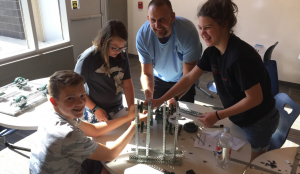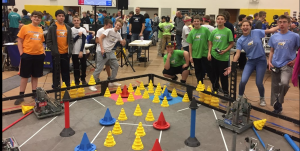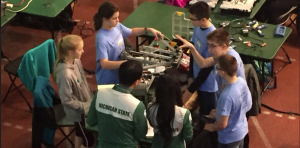About Us
How does this program work?
 Students are placed on teams of 3-5 so everyone has an opportunity to contribute. We provide them with a computer brain, a controller, a standard library of parts and sensors, and an empty engineering notebook.
The students need to study the rules of the game and determine a strategy for how they will compete on the field. Once they have a plan they will take that information and come up with a robot design.
The students then begin the process of building and programming the robot. During this process they will test sub-components of their design and also practice with their robot on the field. They will continue to test and redesign during each practice session until it is time for competition.
We try to get our teams to compete often so they can gain experience and evaluate the performance of their robot. During competitions, students will collaborate with other teams on the field and they can watch how other teams compete. Using this information they can return our build center to figure out a design improvement that helps them win.
Students are placed on teams of 3-5 so everyone has an opportunity to contribute. We provide them with a computer brain, a controller, a standard library of parts and sensors, and an empty engineering notebook.
The students need to study the rules of the game and determine a strategy for how they will compete on the field. Once they have a plan they will take that information and come up with a robot design.
The students then begin the process of building and programming the robot. During this process they will test sub-components of their design and also practice with their robot on the field. They will continue to test and redesign during each practice session until it is time for competition.
We try to get our teams to compete often so they can gain experience and evaluate the performance of their robot. During competitions, students will collaborate with other teams on the field and they can watch how other teams compete. Using this information they can return our build center to figure out a design improvement that helps them win.
 Students are placed on teams of 3-5 so everyone has an opportunity to contribute. We provide them with a computer brain, a controller, a standard library of parts and sensors, and an empty engineering notebook.
The students need to study the rules of the game and determine a strategy for how they will compete on the field. Once they have a plan they will take that information and come up with a robot design.
The students then begin the process of building and programming the robot. During this process they will test sub-components of their design and also practice with their robot on the field. They will continue to test and redesign during each practice session until it is time for competition.
We try to get our teams to compete often so they can gain experience and evaluate the performance of their robot. During competitions, students will collaborate with other teams on the field and they can watch how other teams compete. Using this information they can return our build center to figure out a design improvement that helps them win.
Students are placed on teams of 3-5 so everyone has an opportunity to contribute. We provide them with a computer brain, a controller, a standard library of parts and sensors, and an empty engineering notebook.
The students need to study the rules of the game and determine a strategy for how they will compete on the field. Once they have a plan they will take that information and come up with a robot design.
The students then begin the process of building and programming the robot. During this process they will test sub-components of their design and also practice with their robot on the field. They will continue to test and redesign during each practice session until it is time for competition.
We try to get our teams to compete often so they can gain experience and evaluate the performance of their robot. During competitions, students will collaborate with other teams on the field and they can watch how other teams compete. Using this information they can return our build center to figure out a design improvement that helps them win.
Engineering notebook
No instruction book is provided - the students have to create their own engineering notebook - and adults are not allowed to contribute. Mentors and coaches are available to help teams figure out the answers to their questions but no adult will tell them how they should design their robot.
The notebook becomes the instruction manual for the robot. The team is encourage to record their strategy, design, drawings, programming, and what they learned each day. There are no mistakes so nothing is erased. The book continues to record a timeline of the team's progress
Competition drives innovation.
 During tournaments teams will compete in qualifying matches and elimination rounds. They will also compete in a solo timed skills events where a student drives the robot and where the robot drives itself (autonomously).
The older VRC teams will compete with four robots on a field in a two minute 2v2 match and the younger IQ teams will collaborate with another team on the field against the clock. The teams for each match are chosen at random so you cannot predict who your partner will be.
Competitions also have other facets besides match play with skills and judging. Drivers and autonomous skills runs are where a team tests their abilities alone on the field against the clock.
During tournaments teams will compete in qualifying matches and elimination rounds. They will also compete in a solo timed skills events where a student drives the robot and where the robot drives itself (autonomously).
The older VRC teams will compete with four robots on a field in a two minute 2v2 match and the younger IQ teams will collaborate with another team on the field against the clock. The teams for each match are chosen at random so you cannot predict who your partner will be.
Competitions also have other facets besides match play with skills and judging. Drivers and autonomous skills runs are where a team tests their abilities alone on the field against the clock.
 During tournaments teams will compete in qualifying matches and elimination rounds. They will also compete in a solo timed skills events where a student drives the robot and where the robot drives itself (autonomously).
The older VRC teams will compete with four robots on a field in a two minute 2v2 match and the younger IQ teams will collaborate with another team on the field against the clock. The teams for each match are chosen at random so you cannot predict who your partner will be.
Competitions also have other facets besides match play with skills and judging. Drivers and autonomous skills runs are where a team tests their abilities alone on the field against the clock.
During tournaments teams will compete in qualifying matches and elimination rounds. They will also compete in a solo timed skills events where a student drives the robot and where the robot drives itself (autonomously).
The older VRC teams will compete with four robots on a field in a two minute 2v2 match and the younger IQ teams will collaborate with another team on the field against the clock. The teams for each match are chosen at random so you cannot predict who your partner will be.
Competitions also have other facets besides match play with skills and judging. Drivers and autonomous skills runs are where a team tests their abilities alone on the field against the clock.
Judging
 At tournaments teams meet with a panel of judges where they defend the design of their robot. Teams will present their notebook and explain their strategy and design process. In the photo the team is presenting to members of the Michigan State University Department of Engineering.
At tournaments teams meet with a panel of judges where they defend the design of their robot. Teams will present their notebook and explain their strategy and design process. In the photo the team is presenting to members of the Michigan State University Department of Engineering.
 At tournaments teams meet with a panel of judges where they defend the design of their robot. Teams will present their notebook and explain their strategy and design process. In the photo the team is presenting to members of the Michigan State University Department of Engineering.
At tournaments teams meet with a panel of judges where they defend the design of their robot. Teams will present their notebook and explain their strategy and design process. In the photo the team is presenting to members of the Michigan State University Department of Engineering.
